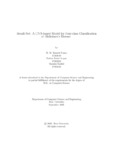| dc.contributor.advisor | Bin Ashraf, Faisal | |
| dc.contributor.advisor | Parvez, Dr. Mohammad Zavid | |
| dc.contributor.author | Hasan, M. M. Kamrul | |
| dc.contributor.author | Angan, Farhan Faisal | |
| dc.contributor.author | Rashid, Tasmim | |
| dc.date.accessioned | 2022-09-11T06:31:15Z | |
| dc.date.available | 2022-09-11T06:31:15Z | |
| dc.date.copyright | 2021 | |
| dc.date.issued | 2021-09 | |
| dc.identifier.other | ID: 17201049 | |
| dc.identifier.other | ID: 17201153 | |
| dc.identifier.other | ID: 17301232 | |
| dc.identifier.uri | http://hdl.handle.net/10361/17194 | |
| dc.description | This thesis is submitted in partial fulfillment of the requirements for the degree of Bachelor of Science in Computer Science, 2021. | en_US |
| dc.description | Cataloged from PDF version of thesis. | |
| dc.description | Includes bibliographical references (pages 48-52). | |
| dc.description.abstract | eep learning, a cutting-edge machine learning technique, has outperformed classical machine learning at detecting detailed structures in complex multi-dimensional
data, particularly in the field of computer vision. As recent advances in neuroimaging techniques have created massive multimodal neuroimaging data, the application
of deep learning to early diagnosis and automated categorization of AD has recently
gotten a lot of interest. It also supports biomedical researchers in the identification
of many diseases such as cancer, Alzheimer’s, Malaria, and blood cell detection,
among others. Deep learning is a subclass of machine learning techniques for extracting features and applying them to classification, image processing, and other
tasks. A thorough Google Scholar search was conducted before and during our research to find deep learning publications on AD published between January 2010
and July 2020. After reading and evaluating, these articles were categorized and
summarized according to their used algorithms and neuroimaging techniques. In
our research, we have used CNN also known as ConvNet which is one of the most
efficient deep learning-based neural networks to classify Alzheimer’s patients from
healthy individuals with the help of MRI data. We have collected our sMRI data
from ADNI. Our dataset includes a total of 6400 patients who were categorized
as non-demented or having mild to severe Alzheimer’s disease. Our deep learning
approach automatically distinguishes different stages of AD subjects according to
their severity. Our proposed model was designed to assist with accurate classifi cation of four classes e.g. NC, EMCI, MCI and AD. Though classification is very
crucial for modeling a prediction model to find out the existence and intensity of
the disease, it has always been quite difficult. Separating the distinctive features
from the ROI is the most challenging part. Our proposed model has a classification
accuracy of 79.77%. The performance of our work was compared to several other
existing approaches for multi-class classification. | en_US |
| dc.description.statementofresponsibility | M. M. Kamrul Hasan | |
| dc.description.statementofresponsibility | Farhan Faisal Angan | |
| dc.description.statementofresponsibility | Tasmim Rashid | |
| dc.format.extent | 52 Pages | |
| dc.language.iso | en_US | en_US |
| dc.publisher | Brac University | en_US |
| dc.rights | Brac University theses are protected by copyright. They may be viewed from this source for any purpose, but reproduction or distribution in any format is prohibited without written permission. | |
| dc.subject | Machine Learning | en_US |
| dc.subject | Deep Learning | en_US |
| dc.subject | Alzheimer | en_US |
| dc.subject | MRI | en_US |
| dc.subject | sMRI | en_US |
| dc.subject | MCI | en_US |
| dc.subject | ADNI | en_US |
| dc.subject | CNN. | en_US |
| dc.subject.lcsh | Cognitive learning theory (Deep learning) | |
| dc.subject.lcsh | Machine learning | |
| dc.title | Recall-Net: A CNN-based Model for Four-class Classification of Alzheimer’s Disease | en_US |
| dc.type | Thesis | en_US |
| dc.contributor.department | Department of Computer Science and Engineering, Brac University | |
| dc.description.degree | B. Computer Science | |

